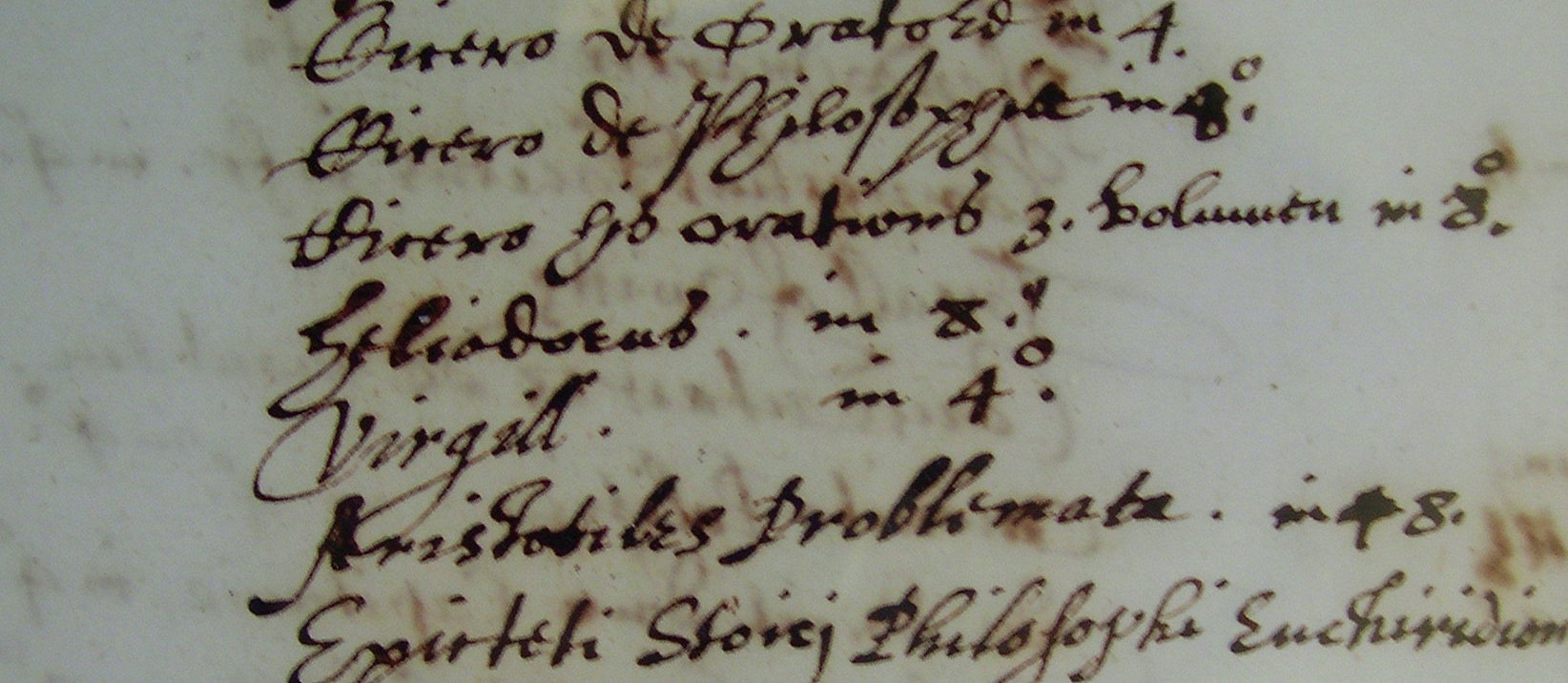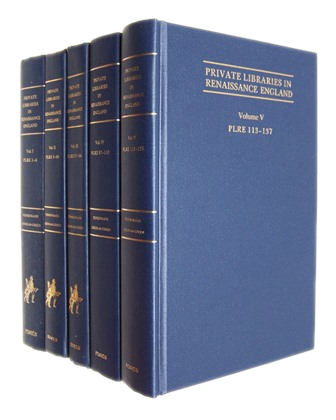PLRE.Folger
Private Libraries in Renaissance England

PLRE
Private Libraries in Renaissance England
A Collection and Catalogue of Tudor and Early Stuart Book-Lists
*
Joseph L. Black, General Editor
University of Massachusetts Amherst
R.J. Fehrenbach, Founding Editor
College of William and Mary
E. S. Leedham-Green, Consulting Editor
Darwin College, Cambridge University
PLRE has been supported by the National Endowment for Humanities, the Gladys Delmas Foundation, the British Academy, and the estate of Mark H. Curtis
Purpose
In the thousands of inventories on decease compiled for the purpose of probate during the sixteenth and seventeenth centuries in England, books are often among the items listed. They are also recorded in a variety of other documents associated with men and women of this period, including wills, account ledgers, receipts, and inventories of goods distrained. Private Libraries in Renaissance England (PLRE) transcribes and annotates such book-lists produced between the beginning of the sixteenth century and the mid-seventeenth century; it also reconstructs private library holdings of that period based on extant books. The information thus derived is then entered into a uniform database which can be searched and from which material about those books and their owners is retrieved and published.
One of the goals of PLRE is to provide scholars with data to help anchor generalizations about print culture within the history of particular books and readers. Edited book-lists and library catalogues provide evidence for the histories of reading and collecting, for the languages in which that reading was conducted, for changing intellectual, educational, and literary fashions, and for the social roles or aspirations of book owners. A library is in itself a kind of collective text: even in the absence of the books themselves, a book-list offers the chance to see how a given book might have been used by placing it against the backdrop of other books owned by the same reader. These inventories can also provide a great deal of information about the book trade. They reveal not only the extensive presence of Continental publications in English inventories, but also, as dated collections, the provable years by which these publications were present in England. They also document changing patterns of probate valuations that provide glimpses into the under-documented history of the used book trade in the period.
Design

In the published volumes of PLRE, each entry in the book-lists is reproduced as it appears in the manuscript source and is provided with the following:
1) a reference number (PLRE number);
2) as identifiable, the title, author and other contributors (such as editors, translators, and illustrators);
3) STC status;
4) publication information such as place, stationers, and date;
5) language;
6) cost or appraised value;
7) the location of that particular copy if extant.
Additional information is provided in a general annotation section. Each edited book-list is also prefaced with a brief biographical introduction focusing on the owner’s books.
As of 2022, PLRE consists of ten fully indexed volumes, all published in the Medieval and Renaissance Texts and Studies Series. The ten volumes contain 299 book-lists, dating from 1507 to 1654, with a total of over 18,000 books. Book-lists in Volumes II-VII are all drawn from inventories taken under the jurisdiction of the Chancellor of Oxford University (exercised by the Vice-Chancellor) and, with a few exceptions, detail libraries of sixteenth- and early seventeenth-century Oxford University scholars. With Volume VII, the editing of the book-lists from the Oxford University Archives was completed.

PLRE.Folger Database
Accessible online at https://plre.folger.edu and searchable in a variety of ways, PLRE.Folger, a project of the Folger Shakespeare Library in Washington, D.C., is a database that consists of:
1) all the annotated book-lists that appear in the published volumes of PLRE and
2) appended book-lists, which do not appear in the printed volumes and are identified in the database with ‘Ad’ prefixed to the PLRE number. If previously published elsewhere, these ‘Ad’ lists are not completely re-edited but are augmented as necessary (e.g., by the provision of uniform titles, PLRE reference numbers, subject categories, and the like) so that they conform to the PLRE format and are subject to retrieval with other entries.
In addition to all the information found in the published volumes of PLRE cited above (with the exception of the biographical introductions), PLRE.Folger contains for each book listed as available: the dates, an identifier for each owner (usually a profession or vocation), and social status of the person associated with the book-list; the purpose of the manuscript containing the book-list (whether, for example, it was a will, an inventory or a receipt); the location in England where the manuscript was drafted and its date; the manuscript’s current location; one or more classifications defining the subject categories of the work; and the current location of that specific book if known.
Thus far, the appended lists add 130 book-lists containing over 2600 books to those appearing in the published volumes. As of 2022, PLRE.Folger consists of 429 book-lists containing a total of over 19,000 books, including entries of multiple books.
The Cumulative Catalogue
The Cumulative Catalogue is a series of indices and concordances to the complete PLRE database. The Cumulative Catalogue, which appears near the end of each volume of PLRE, is regularly enlarged and revised to incorporate newly edited book-lists.
The material includes the total number of book-lists edited and entries catalogued; the names of the owners of book-lists arranged alphabetically and by PLRE number (both lists with each owner's dates, profession or vocation, social status, and the date of the manuscript list), a bibliography of the appended (‘Ad’) book-lists alphabetized according to the owners' names; and concordances listing (with PLRE numbers) the types of manuscripts and their dates, the Renaissance locations of the book-lists, and the professions or vocations, social positions, and dates of the book owners.
